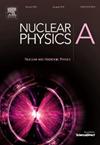在RIBF中使用OEDO和SHARAQ替代中子捕获速率的反应
IF 2.5
4区 物理与天体物理
Q2 PHYSICS, NUCLEAR
引用次数: 0
摘要
为了确定放射性原子核的中子俘获率,我们开发了一种使用替代反应的实验技术,特别是逆运动学中的(d, p)反应。通过识别出的反应残基来推导出非束缚态的γ发射概率,而不是检测来自化合物态的去激发γ射线。通过使用能够使光束减速和聚焦的OEDO装置和RIBF的SHARAQ光谱仪,这样的实验变得可行。我们应用该技术测量了79Se的中子俘获率,用于核嬗变数据,以及130Sn的中子俘获率,用于r过程相关的研究。在这篇文章中,我们用替代比值法讨论了79Se的中子捕获截面,并介绍了130Sn测量的最新实验装置。本文章由计算机程序翻译,如有差异,请以英文原文为准。
The surrogate reactions for the neutron-capture rate using OEDO and SHARAQ in RIBF
To determine the neutron capture rates of radioactive nuclei, we have developed an experimental technique using surrogate reactions, specifically the (d, p) reaction in inverse kinematics. The gamma-emission probabilities from unbound states were deduced by identifying the outgoing reaction residues, instead of detecting the de-excitation rays from the compound states. Such experiments have become feasible through the use of the OEDO device, which enables beam deceleration and focusing, and the SHARAQ spectrometer at RIBF. We applied this technique to measure the neutron capture rates of Se for nuclear transmutation data, and of Sn for studies related to the -process. In this contribution, we discuss the neutron-capture cross sections of Se using the surrogate ratio method, and introduce the updated experimental setup for the Sn measurement.
求助全文
通过发布文献求助,成功后即可免费获取论文全文。
去求助
来源期刊

Nuclear Physics A
物理-物理:核物理
CiteScore
3.60
自引率
7.10%
发文量
113
审稿时长
61 days
期刊介绍:
Nuclear Physics A focuses on the domain of nuclear and hadronic physics and includes the following subsections: Nuclear Structure and Dynamics; Intermediate and High Energy Heavy Ion Physics; Hadronic Physics; Electromagnetic and Weak Interactions; Nuclear Astrophysics. The emphasis is on original research papers. A number of carefully selected and reviewed conference proceedings are published as an integral part of the journal.
 求助内容:
求助内容: 应助结果提醒方式:
应助结果提醒方式:


